Curated by KJ Abudu, Traces of Ecstasy is an architectural pavilion, art exhibition, and symposium that premiered at the 2024 Lagos Biennial. Guided by the biennial's overarching theme of refuge, the curatorial project critically responds to the charged historical residues of Tafawa Balewa Square, taking its constitutive role in postcolonial nation-building as a point of departure. Traces of Ecstasy aims to unsettle the colonial capitalist power structures that maintain and reproduce the ideological legitimacy of the nation-state in post/neocolonial Africa and the wider world.
Providing a space for critique, repair, and "freedom-dreaming", Traces of Ecstasy featured artists from the African continent and its diasporas, including Nolan Oswald Dennis, Evan Ifekoya, Raymond Pinto, Temitayo Shonibare, and Adeju Thompson/Lagos Space Programme'. The former three participated in preliminary residencies at G.A.S. Foundation in 2022 and 2023, to conduct research to inform their work. The exhibition presents works spanning sculpture, video, sound, textiles, performance, and digital art. The project is titled after an essay by Rotimi Fani-Kayode, an exiled British-Nigerian artist whose photographic works combined Yoruba ritualistic practice and transgressive eroticism to destabilise colonial fictions of nationality and positivist rationality. Equally oriented toward a future horizon of decolonial liberation, Traces of Ecstasy hopes to illuminate alternative, anarchic forms of African collectivity for the twenty-first century.
PARTICIPATING ARTISTS
1. Nolan Oswald Dennis
Traces of Ecstasy Pavilion, 2024
Concrete bricks, wood, aluminium roofing sheet
2. Evan Ifekoya
Three States of Water: The Flood, 2023
Sound installation (stereo sound), dried gourds, speakers, subwoofer. Dimensions variable.
3. Adeju Thompson/Lagos Space Programme
Aerial Proposition III (Post-àdire), 2024
Indigo-dyed textiles
10m × 3m (each)
4. Nolan Oswald Dennis
Black Earth Corpus, 2024
Monitor, joystick, local server
Dimensions variable
5. Temitayo Shonibare
By Divine Decree!!, 2024
Three-channel video (colour and sound), metal supporting structure
PAVILION
Designed by Nolan Oswald Dennis, the pavilion's modular structure and overlapping curvilinear facades reference the recursive, fractal geometries of African indigenous space-making practices as well as contemporary makeshift architectures. Composed of concrete bricks aligned with wooden supports to form a breeze-block pattern, the pavilion's facades further allude to postcolonial modernist buildings constructed during the mid-twentieth century African decolonization movements. As a sculptural composite of past, present and future spatial grammars, the pavilion simultaneously spurs critical engagements with liberatory speculations beyond the surrounding site.

Interior view, Traces of Ecstasy Pavilion, 2024. Photography by Amanda Iheme. Photo courtesy of KJ Abudu.
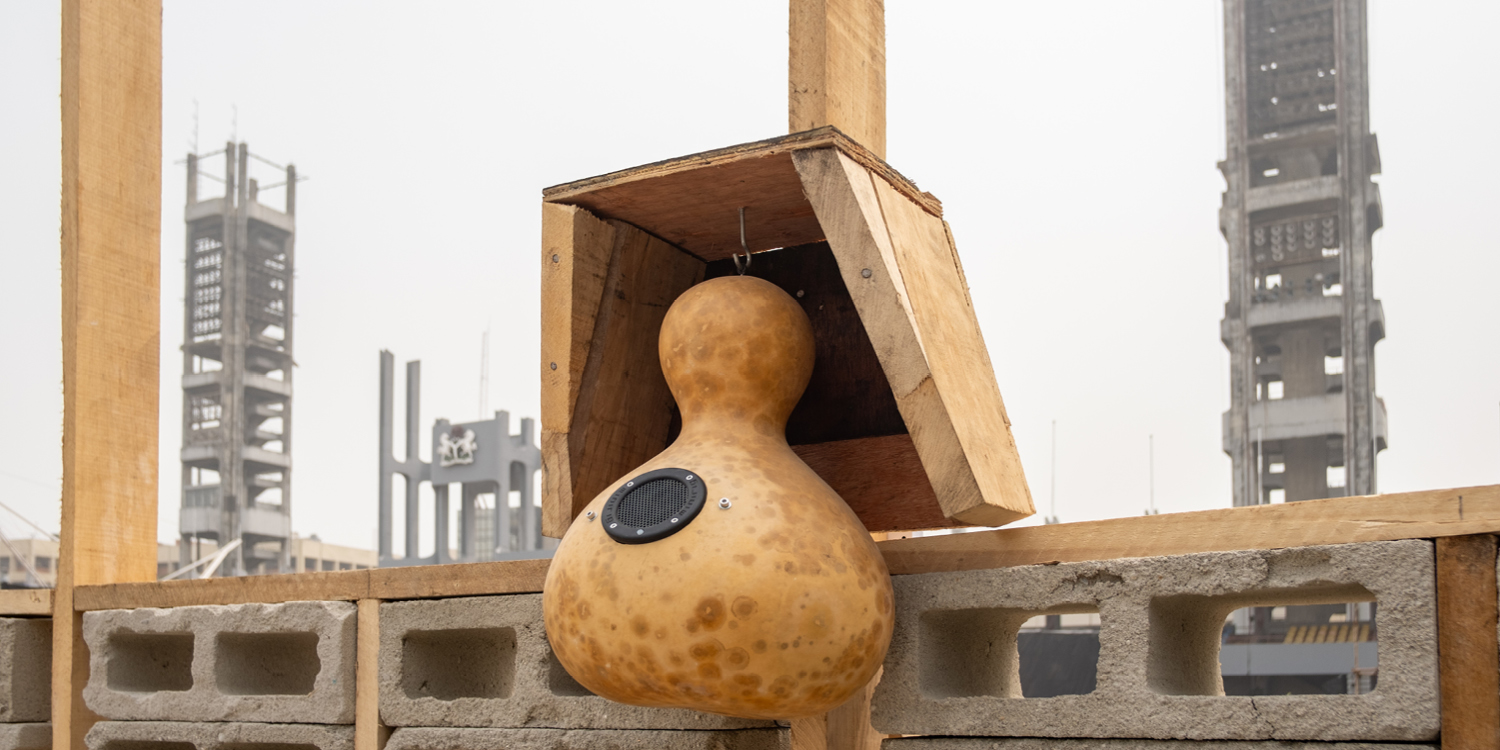
Evan Ifekoya, Three States of Water: The Flood, 2023. Sound installation (stereo sound), dried gourds, speakers, subwoofer. Dimensions variable. Photography by Amanda Iheme. Photo courtesy of KJ Abudu.
Evan Ifekoya's installation explores the reparative and knowledge-producing capacities of sound. Incorporating sounds of water in various state changes, the work metaphorically alludes to the melting, liquefaction, and sublimation of the postcolonial nation-state. Such fluidity further points to queer, non-statist possibilities that destabilize structures of national, gender, sexual, and ethnic identification. Ifekoya's immersive sound score also includes speeches by Tafawa Balewa, Yoruba polyrhythmic drumming, and the artist's spoken narrations on healing and self-knowing. The speakers are also made from dried calabash gourds, which in various West African cosmologies are mythically linked to the creation of the universe and symbolise, via their double spherical shape, the porous relation between the physical world of the living and the metaphysical world of the spirits, ancestors, and the unborn.
As vessel forms, calabash gourds also embody indigenous conceptions of the person as an open receptacle as opposed to a unitary, enclosed, biologically determined entity.
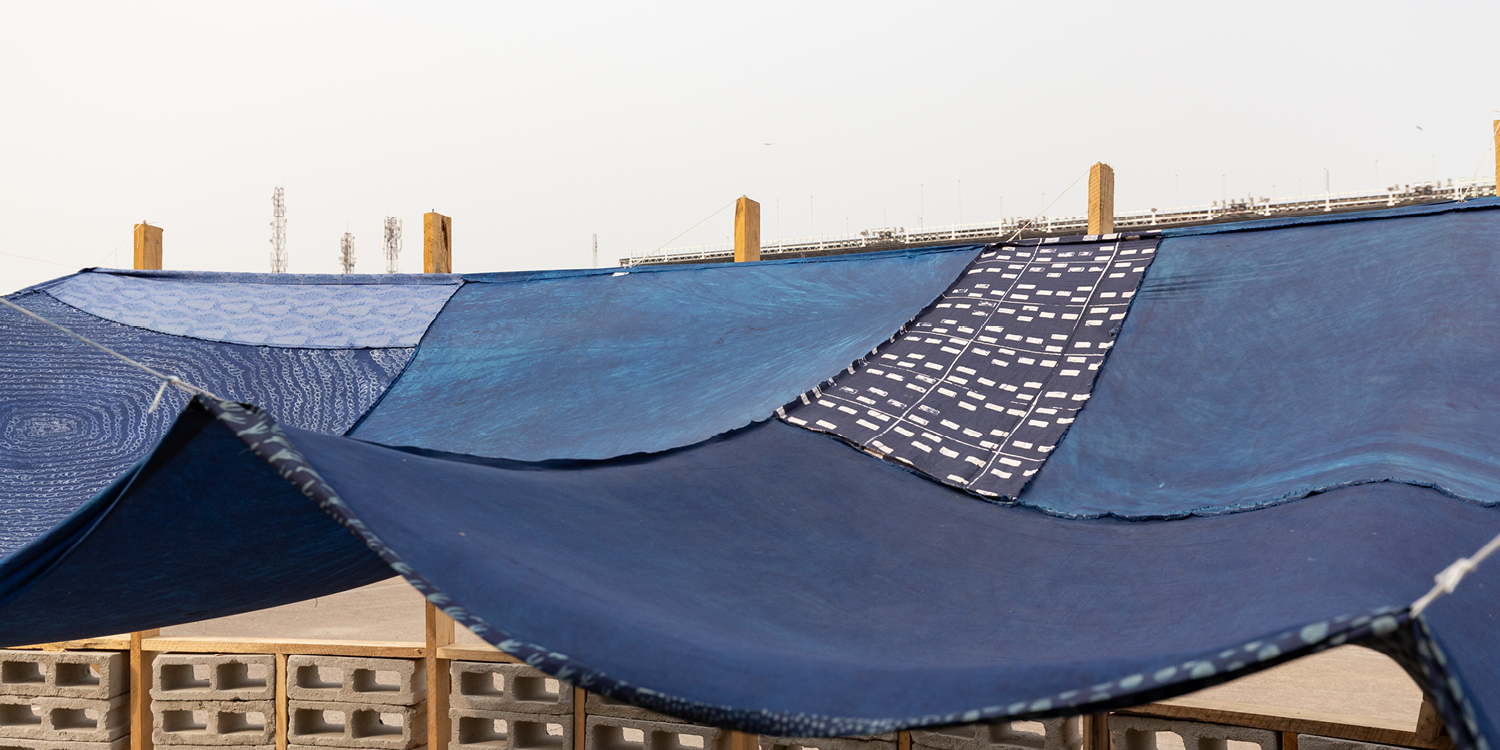
Adeju Thompson, Aerial Proposition III (Post-àdire), 2024. Photography by Amanda Iheme. Photo courtesy of KJ Abudu.
Thompson plays with monumental scale in their suspended works, continuing their ongoing research into reanimating Yoruba clothing styles and textile practices in a twenty-first century context. Since the founding of their experimental, gender-fluid fashion label, Lagos Space Programme, Thompson has specifically taken to dire a resist indigo-dyeing technique long practiced by the Yoruba in what is today southwestern Nigeria. Coining the term "post-àdire" to categorise their formal innovations within this indigenous textile tradition, Thompson scales up their technical and conceptual concerns in these pieces, which were created in collaboration with women artisans in the city of Abeokuta.
Thompson creates bumps and folds in the works' surfaces, these roughened textures suggesting the scarred, brutalized skin of the postcolonial African body politic. Further evoking market tarps and ephemeral architectures for refuge, the indigo-dyed fabric sculptures provide a sense of protection and communal gathering for the viewer's body, while their alternating abstract and botanical patterns preserve the historically communicative capacities of West African textiles.
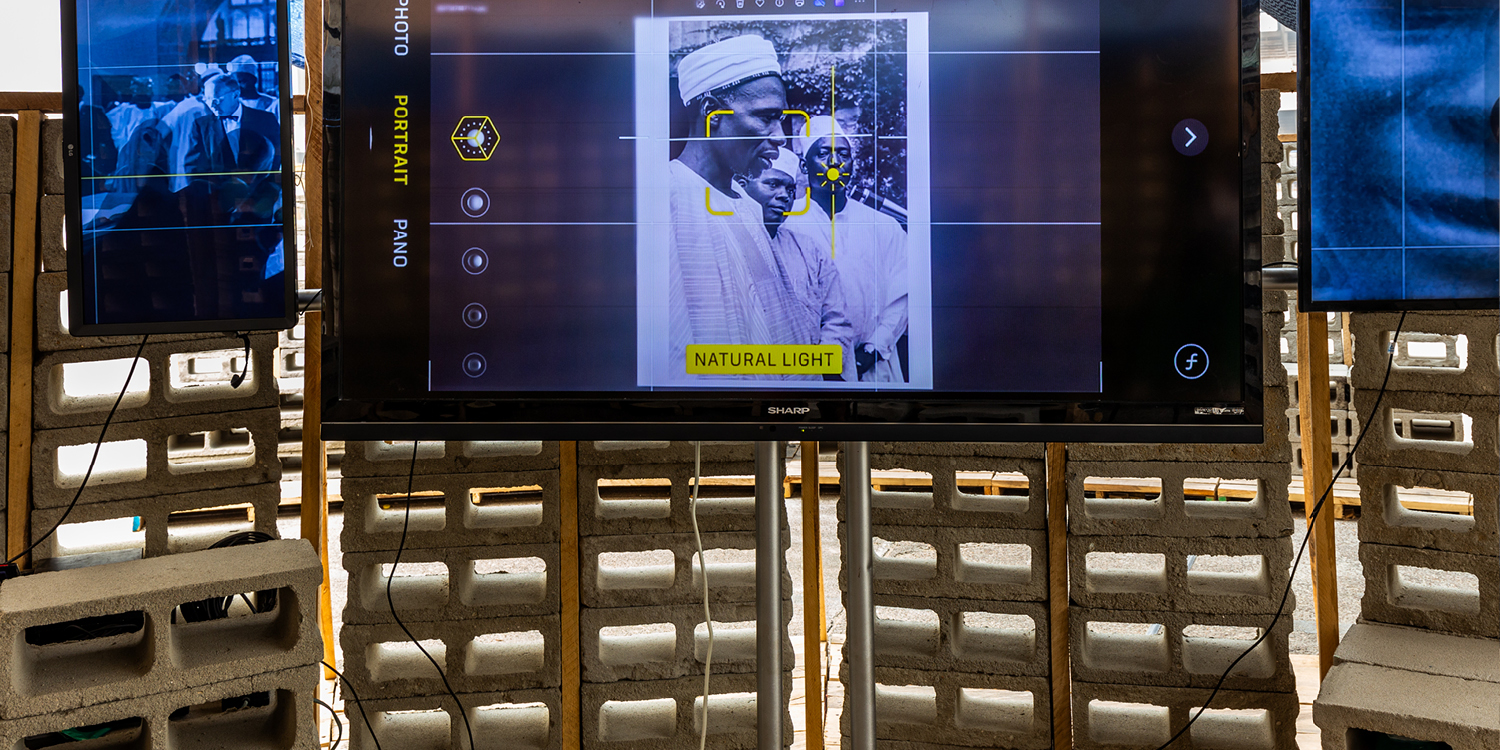
Temitayo Shonibare, By Divine Decree!!, 2024, Three-channel video (colour and sound), metal supporting structure. Photography by Amanda Iheme. Photo courtesy of KJ Abudu.
PERFORMANCE
Diffractions by Raymond Pinto
On February 4th, at the Traces of Ecstasy pavilion, artist and choreographer Raymond Pinto shared his roving performance at the Traces of Ecstasy pavilion. Joined by sound artists, Ayomide Kalejaiye (SAROSAYÉ) and Xavier Emmanuel, the performance responds to the pavilion's architecture through a score that combines bodily movement and experimental music. Pinto's piece takes the gestures of the Gelede masquerade as a starting exploratory point - a masquerade ritually performed by men in honour of female deities and ancestors. Further inspired by the masquerade's adornments, Pinto performed in garments specially designed by Adeju Thompson. Through layered arrangements of clothing, music and dance, the performance reframes indigenous spirituality and Black diasporic archives of sound and movement to illuminate decolonial registers of queer embodiment.
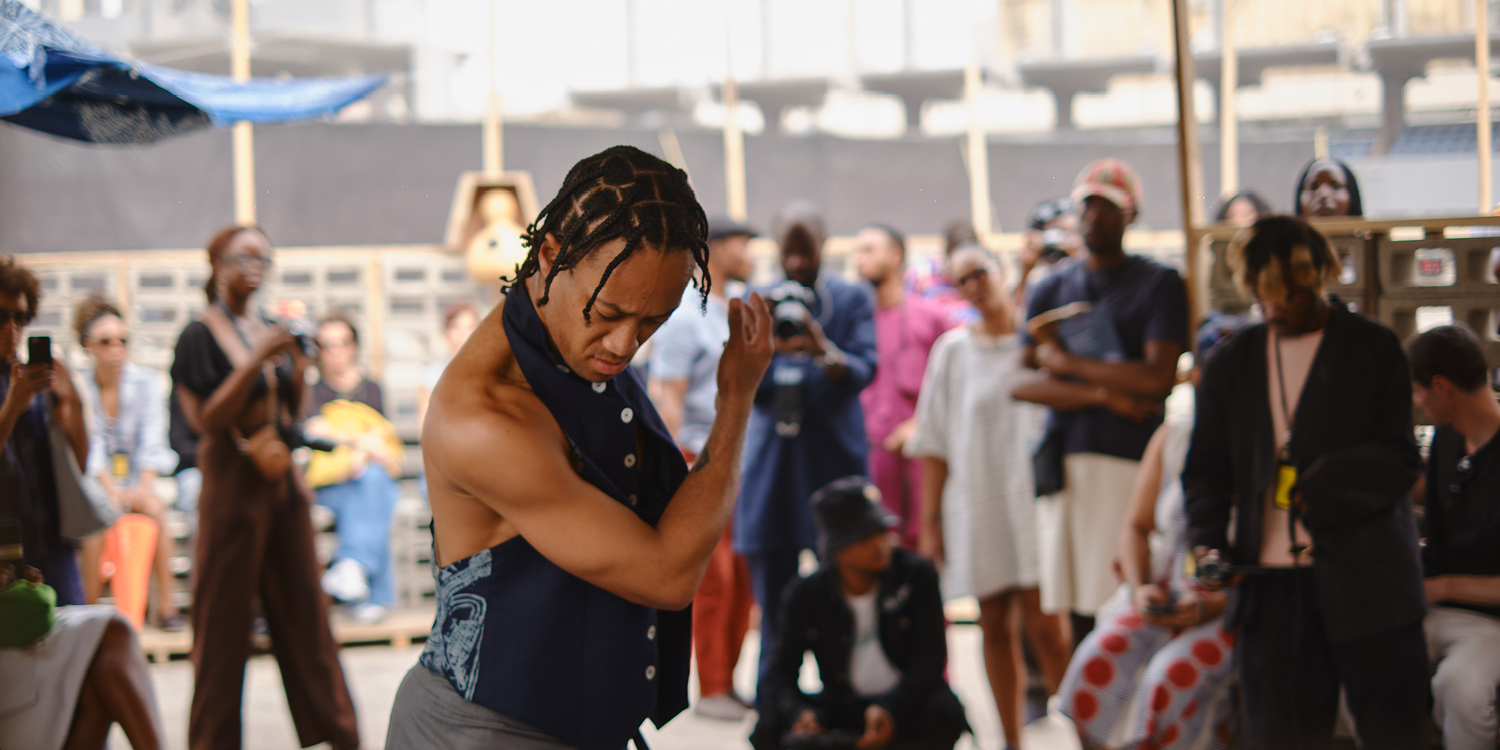
Raymond Pinto performing Diffractions. Photography by Olanrewaju Ali. Photo © G.A.S. Foundation.

Raymond Pinto performing Diffractions. Photography by Olanrewaju Ali. Photo © G.A.S. Foundation.
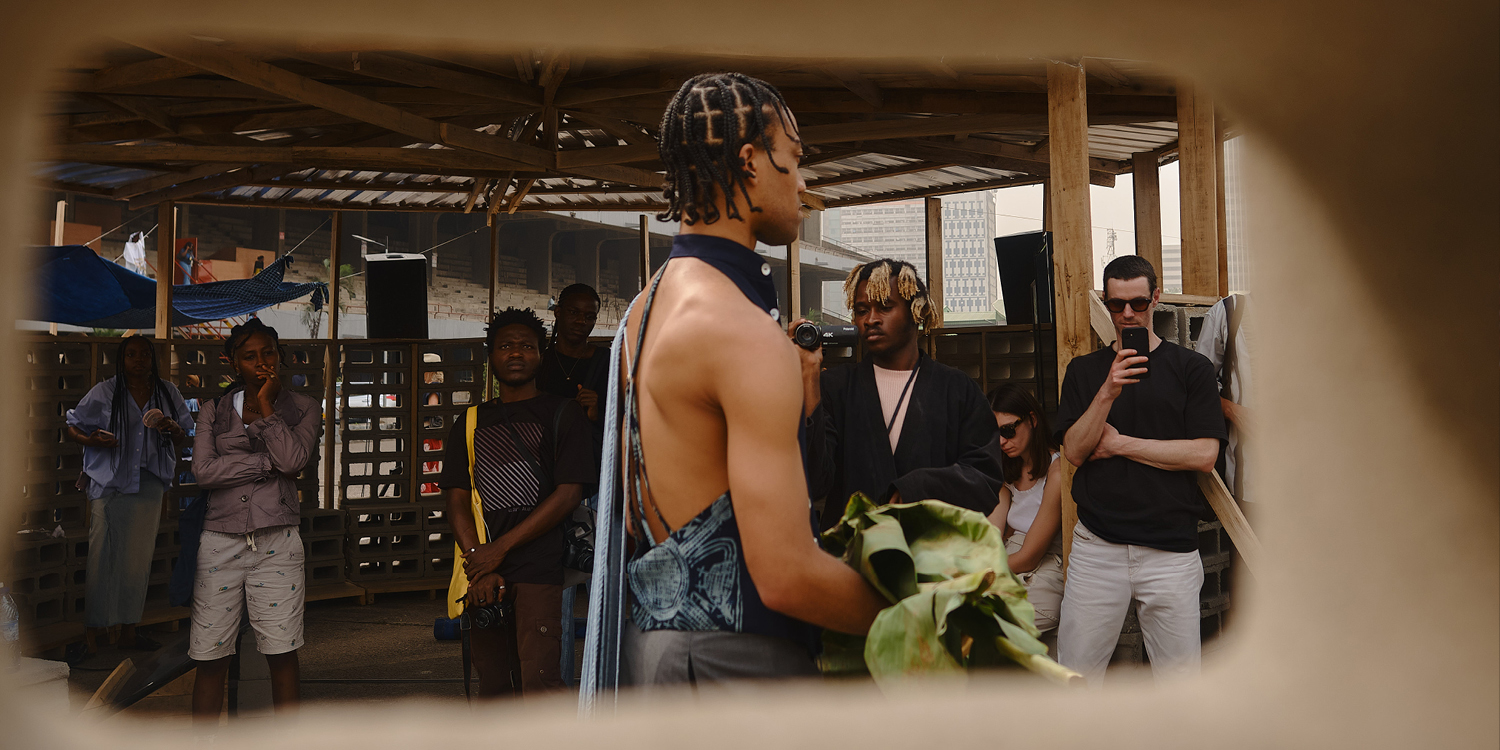
Raymond Pinto performing Diffractions. Photography by Olanrewaju Ali. Photo © G.A.S. Foundation.
SYMPOSIUM
February 7, at Alliance Francaise de Lagos
Gathering artists, writers, and scholars whose works have informed the theoretical thrust of Traces of Ecstasy, the accompanying symposium includes presentations and discussions exploring a variety of relevant themes such as the fraught relationship between colonial modernity and African indigeneity; the pitfalls of postcolonial statecraft; the intersections of critical African studies and queer and feminist theory; and the affinities between African metaphysical schemes and digital technologies. The symposium's speakers include those listed below, with introductory and concluding remarks by KJ Abudu:
Zoé Samudzi, "Postcolonial Horror, Haunted States"
Roberto Strongman, "Transcorporealitu in Afro-Hispanic Religion"
Neema Githere, "Afropresentism: Journeying through the Age of Total Recall"
Nolan Oswald Dennis, "UBU-NTU: Architectural and Virtual Spatialtes of Being-Becoming"
Emmanuel Iduma, A Reckoning with Silence. inheritance and History
Text courtesy of KJ Abudu.